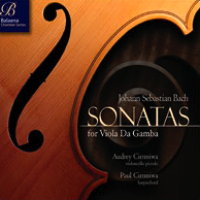
The Gamba Problem
Music by J S Bach -
heard by
GEORGE BALCOMBE'... a number of oddities ...'
|

|
It seems somewhat perverse that Sonata Form, which only began to crumble around the 1930s, had been so long in arriving that Johann Sebastian Bach thought it not worth bothering with. He died before Sonata Form seriously took control of European music.
It was perhaps not exactly perverse that in 1729 Bach managed to slip in Three Sonatas for Viola da Gamba and Harpsichord amongst his otherwise crowded schedule.
He was no foreigner to the viola da gamba but there seems to be scholarly dispute about how the three gamba sonatas came about. The most popular theory is that Bach composed these sonatas for the University of Leipzig's Collegium Musicum which Bach directed from 1729.
Such historical niceties are always fascinating, but hardly vital. However, in this case of the three sonatas, the disputes clearly have substance, which is more technical than musical. The point is, they do concern this CD as well as Audrey and Paul Cienniwa who respectively play solo violoncello piccolo and harpsichord.
Listen -- J S Bach: Allegro ma non tanto (BWV 1027)
(track 2, 0:00-1:01) © 2009 whaling city sound
What maybe termed the Gamba Problem is all to do with 'fingering', which should perhaps be more accurately referred to as 'thumbing'.
Problem one. Gamba. The viola da gamba is, so to speak, the viol consort's cello. It has a deep tone but is too quiet to mix with the violin family.
Problem two. Cello. Because the cello belongs to the violin family, it can project loudly, but lacks the beautiful, echoing resonance of the viola da gamba.
Problem three. Violoncello piccolo. First made in the mid-1700s by Stradivarius. It resembles the normal cello but has a higher pitch, fewer decibels and a thinner sound at the deep end.
Problem four. Fingering. For all three of the above instruments, fingering becomes more difficult in the higher strings. Bach's Cello Suites, for example, demand superhuman gymnastics in the soloist's left hand when the thumb joins the other four fingers on the highest part of the piccolo cello's highest string which is tuned to a high E.
The obvious solution to problem four would be to avoid all high notes. But composers and their patrons and audiences are only human and expect, and get, the impossible.
Listen -- J S Bach: Allegro (BWV 1029)
(track 6, 2:25-3:33) © 2009 whaling city sound
This CD of Bach's Three Sonatas for Viola da Gamba does not, in fact, have a viola da gamba at all, nor, for that matter, does it have a Guanerius or any other make of cello.
Instead, Audrey Cienniwa opted for a violoncello piccolo. And that is where this reviewer parts company with this CD, which seems to have a number of oddities, that observation not referring, of course, to the more than twenty souls who brought this CD into existence.
It seems eccentric to give this CD the title Sonatas for Viola Da Gamba when the CD is actually a recording of violoncello piccolo.
True, J S Bach is well-known for transcribing his own compositions, so why should not the same facility be allowed to other performers of his music? After all, for centuries, cellists have played Bach's six unaccompanied cello suites, the last of which was given to the violoncello piccolo. To make a fuss about this or that kind of cello might be regarded as trivial.
But the explanatory notes written here by Catherine Gordon-Seifert have been thoroughly researched. She demonstrates the musical outcome resulting from the tuning of the strings, so that gamba, cello and piccolo cello have profoundly different sounds.
The gamba has six strings and 'poses specific challenges for modern cellists, particularly the high notes which must be played in thumb position'.
The cello has four strings and the piccolo cello sometimes has five strings, 'most likely to distinguish this smaller cello from its larger counterpart'.
Some piccolo cellos included a fifth string tuned to E in addition to the usual C G D A. This E enabled the performer to 'avoid constantly playing in thumb position: thus the tuning is more accurate and the sound less tense'.
These details clearly show that the sound is significantly influenced by string technicalities.
Catherine Gordon-Seifert concludes her notes by saying that Bach's Viola Da Gamba Sonatas can certainly be played on the five-string piccolo cello with 'grace and beauty'.
These qualities seem to be missing from the CD's three sonatas.
Nevertheless, all is not lost because the recital ends with extracts from Cantata 175 'Es dünket mich' and Cantata 183 'Ich fürchte nicht'.
Listen -- J S Bach: Ich fürchte nicht (Cantata 183)
(track 13, 6:06-7:23) © 2009 whaling city sound
Suddenly, the CD comes alive. The piccolo cello has some human feeling after all.
Copyright © 2 November 2009
George Balcombe,
London UK
 CD INFORMATION: BACH SONATAS FOR VIOLA DA GAMBA
CD INFORMATION: BACH SONATAS FOR VIOLA DA GAMBA
| 
